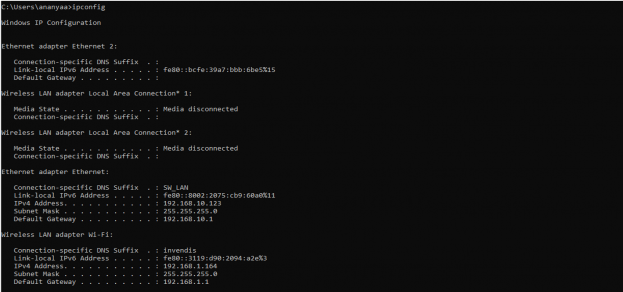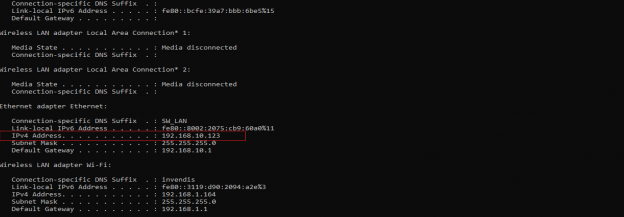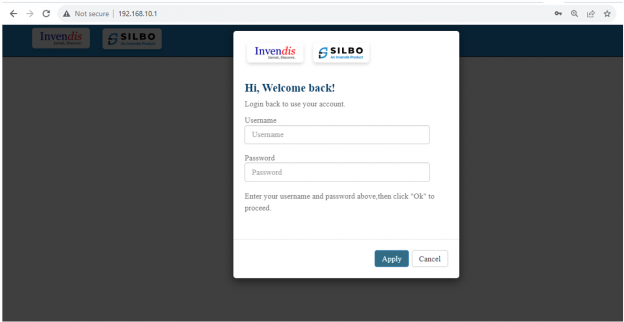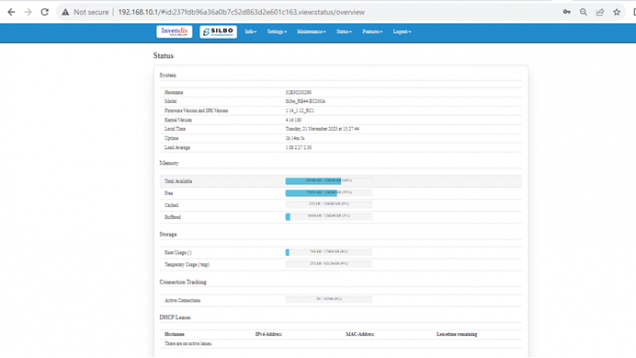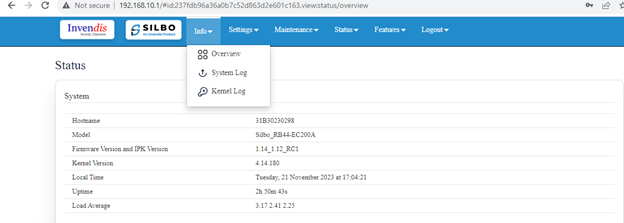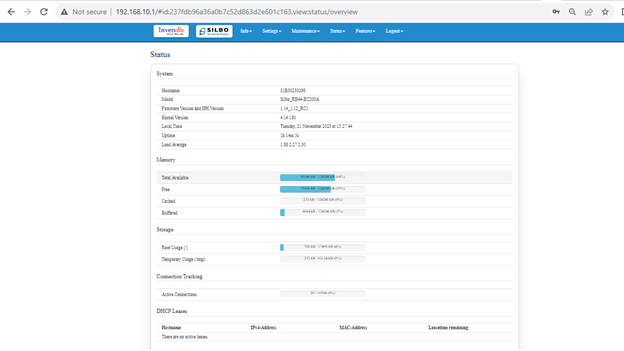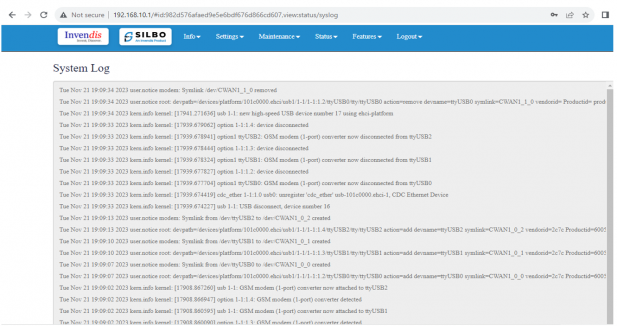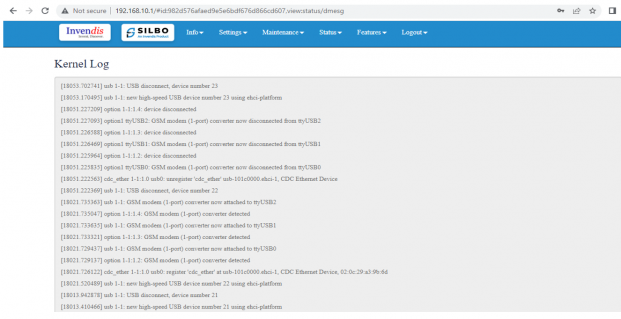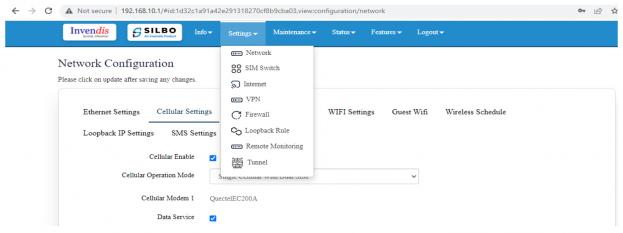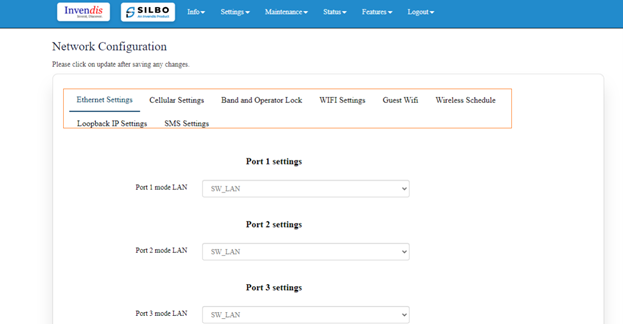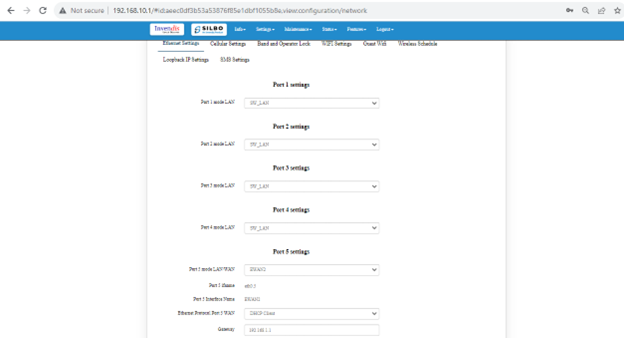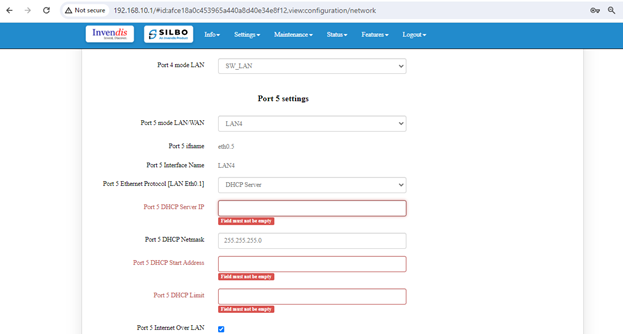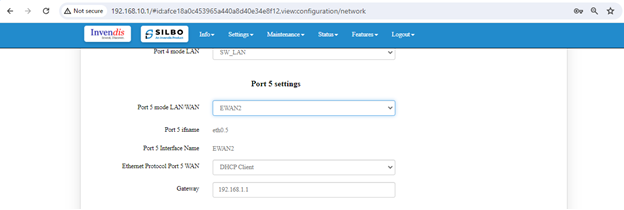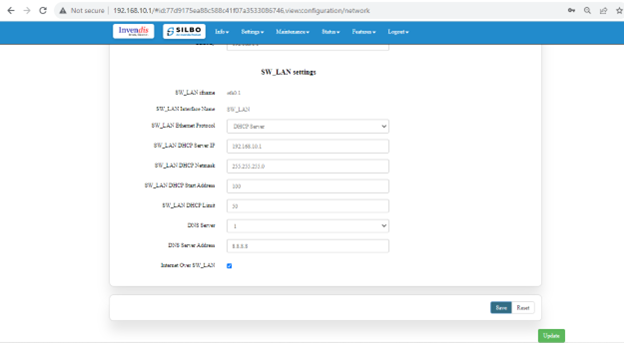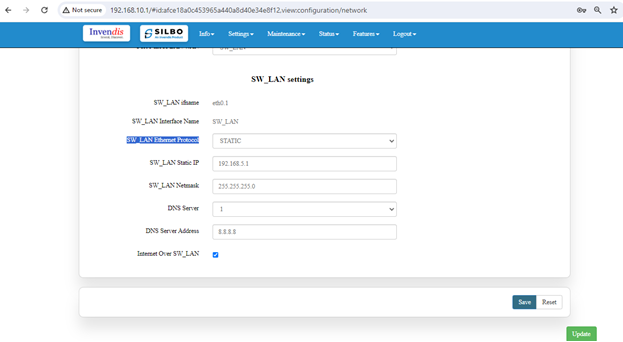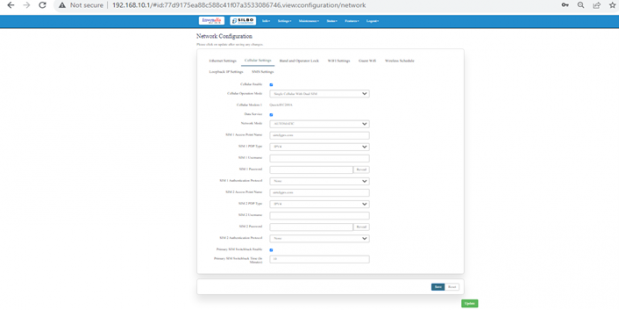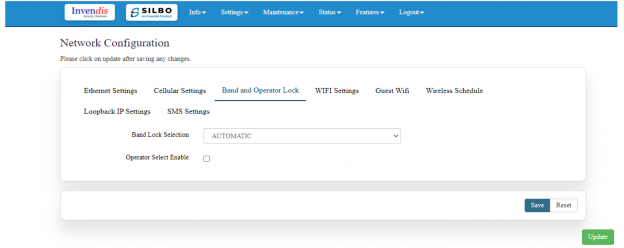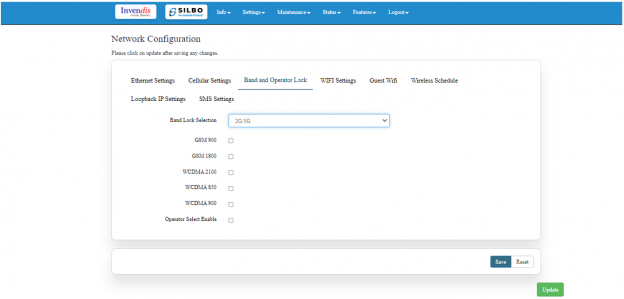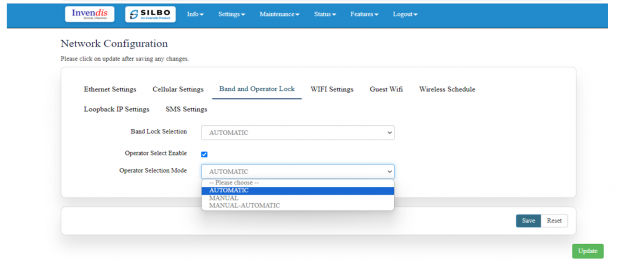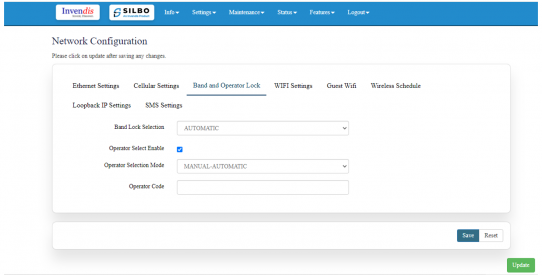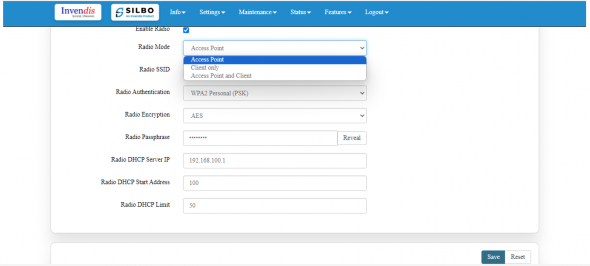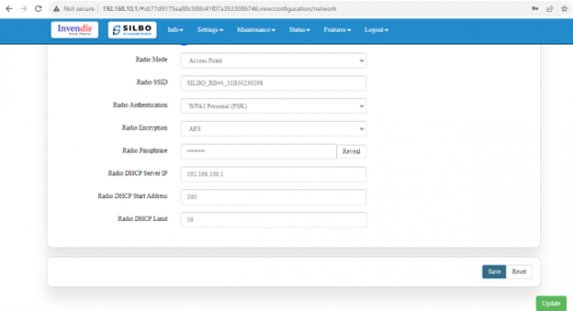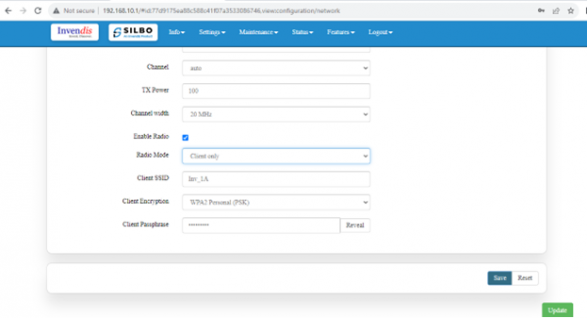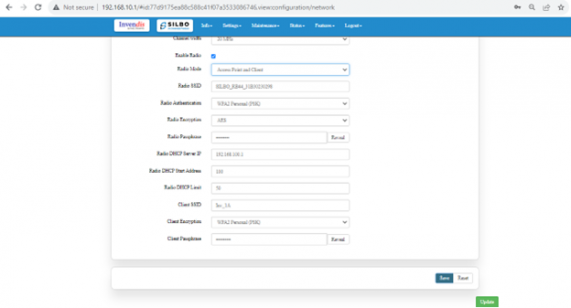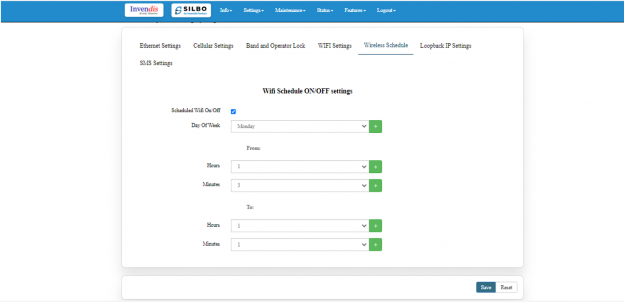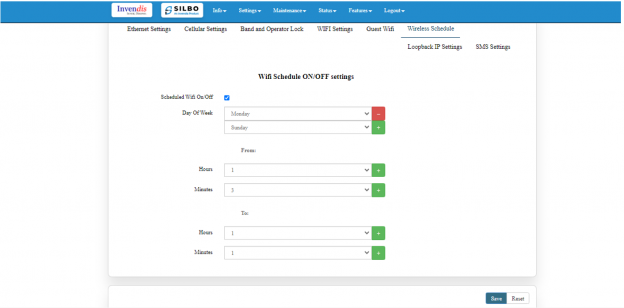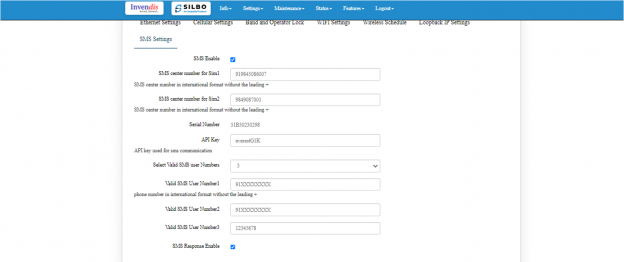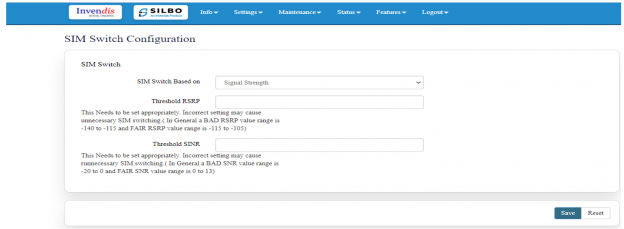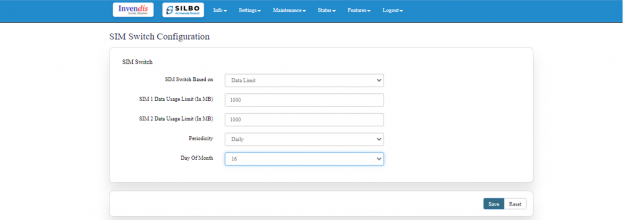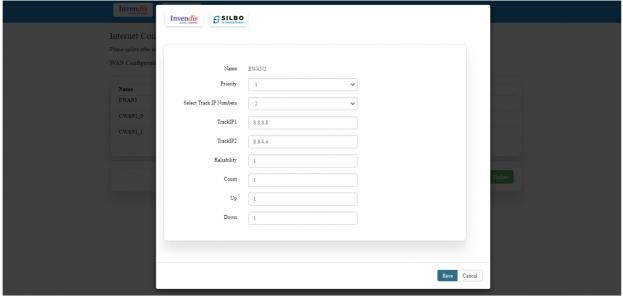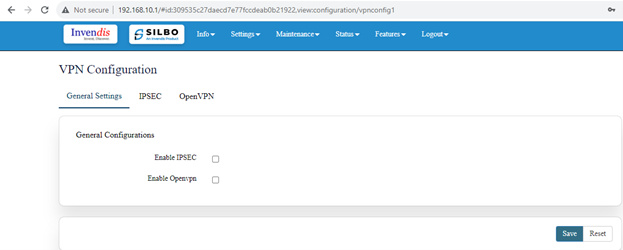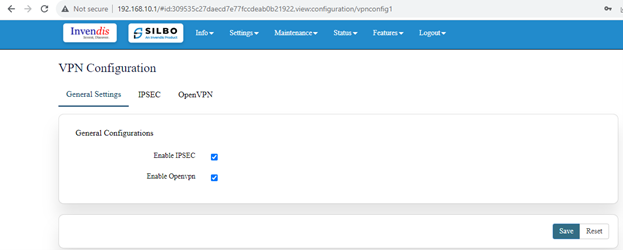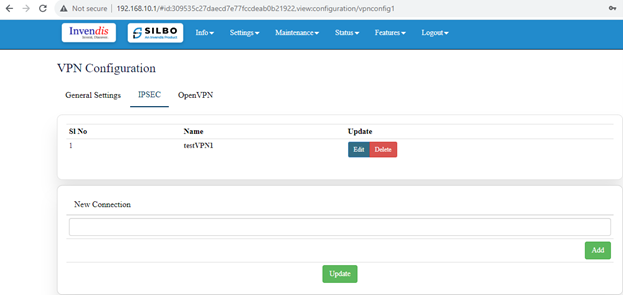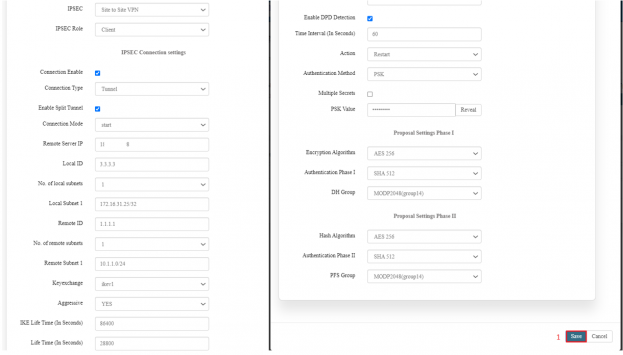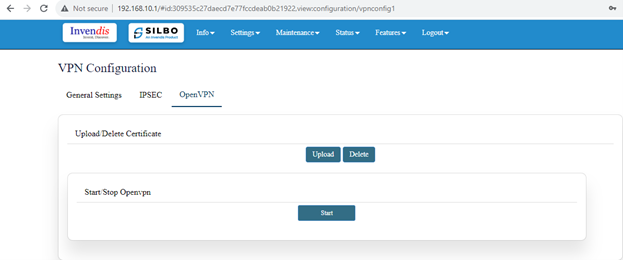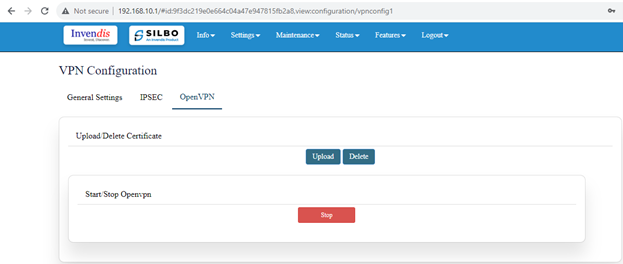RB44 Manual: Difference between revisions
(→SIM) |
No edit summary |
||
| Line 252: | Line 252: | ||
In this page, the user gets to view the Kernel logs | In this page, the user gets to view the Kernel logs | ||
[[File:Kernel Log.png|frameless|621x621px]] | [[File:Kernel Log.png|frameless|621x621px]] | ||
| Line 743: | Line 744: | ||
User needs to enable SMS option in SMS settings page. This option is to validate the mobile numbers using which controlling commands could be sent to the router device. 1 to 5 mobile numbers can be authenticated by choosing from “Select Valid SMS user numbers” and adding the mobile numbers below respectively. API key is the pass key used in the commands while sending SMS. Displayed in the below screen is the default API key which can be edited and changed as per choice. After addition of the mobile numbers user needs to click on save button for changes to take place. | User needs to enable SMS option in SMS settings page. This option is to validate the mobile numbers using which controlling commands could be sent to the router device. 1 to 5 mobile numbers can be authenticated by choosing from “Select Valid SMS user numbers” and adding the mobile numbers below respectively. API key is the pass key used in the commands while sending SMS. Displayed in the below screen is the default API key which can be edited and changed as per choice. After addition of the mobile numbers user needs to click on save button for changes to take place. | ||
[[File:SMS Settings.png|frameless|624x624px]] | [[File:SMS Settings.png|frameless|624x624px]] | ||
| Line 762: | Line 765: | ||
===SIM=== | ===SIM=== | ||
In this page the user needs to configure the Sim for the given device. | |||
[[File:SIM Switch.png|frameless|624x624px]]The user needs to select from the drop-down menu on which basis the sim needs to be switched. | |||
[[File:Sim Switch Configuration.png|frameless|624x624px]] | |||
Once the user selects on “'''signal strength'''” then the parameters related to signal strength will pop up and the user needs to configure the parameters based on the requirement | |||
[[File:Signal Strength.png|frameless|624x624px]] | |||
'''Threshold RSRP''' | |||
This Needs to be set appropriately. Incorrect setting may cause unnecessary SIM switching. ( In General a BAD RSRP value range is -140 to -115 and FAIR RSRP value range is -115 to -105). | |||
'''Threshold SINR''' | |||
This Needs to be set appropriately. Incorrect setting may cause unnecessary SIM switching. ( In General a BAD SNR value range is -20 to 0 and FAIR SNR value range is 0 to 13) | |||
Once the user selects on “'''Data Limit'''” then the parameters related to Data Limit will pop up and the user needs to configure the parameters based on the requirement. | |||
[[File:Data limit.png|frameless|623x623px]] | |||
{| class="wikitable" | |||
|SN | |||
|Field name | |||
|Sample value | |||
|Description | |||
|- | |||
|1 | |||
|SIM Switch Based on | |||
|Data Limit | |||
|The user needs to select from the drop-down menu on what basis the sim needs to be switched. | |||
|- | |||
|2 | |||
|SIM 1 Data Usage Limit (In MB) | |||
|1000 | |||
|The user needs to set the limit for the data usage for SIM 1. | |||
|- | |||
|3 | |||
|SIM 2 Data Usage Limit (In MB) | |||
|1000 | |||
|The user needs to set the limit for the data usage for SIM 2. | |||
|- | |||
|4 | |||
|Periodicity | |||
|Daily | |||
|The user needs to set the pattern/frequency to switch the sims. | |||
|- | |||
|5 | |||
|Day Of Month | |||
|16 | |||
|The user needs to set the day for switching the sim. | |||
|} | |||
After configuring all the required information, the user should click on the save. | |||
===Internet=== | ===Internet=== | ||
In this page the user needs to configure the internet connection to set the priority from the various options. The user should decide what kind of connection it needs to provide to the device like LAN, WAN etc. Once the connections are configured then click on save option and then on update. | |||
[[File:Internet.png|frameless|624x624px]] | |||
If the user needs to edit on the existing configuration, then the user should click on the “EDIT” button. | |||
[[File:Network Edit Options.png|frameless|623x623px]] | |||
{| class="wikitable" | |||
|SN | |||
|Field name | |||
|Sample value | |||
|Description | |||
|- | |||
|1 | |||
|Name | |||
|EWAN2 | |||
|This field displays the name of the WAN connection | |||
|- | |||
|2 | |||
|Priority | |||
|1 | |||
|In this dropdown box the user need to select the priority. | |||
|- | |||
|3 | |||
|Select Track IP Numbers | |||
|2 | |||
|In this dropdown the user needs to select the track number for the Ips. | |||
|- | |||
|4 | |||
|TrackIP1 | |||
|8.8.8.8 | |||
|In this text field the user needs to set the IP address for the track 1 | |||
|- | |||
|5 | |||
|TrackIP2 | |||
|8.8.4.4 | |||
|In this text field the user needs to set the IP address for the track 1 | |||
|- | |||
|6 | |||
|Reliability | |||
|1 | |||
|Not sure what needs to be written | |||
|- | |||
|7 | |||
|Count | |||
|1 | |||
|Not sure what needs to be written | |||
|- | |||
|8 | |||
|Up | |||
|1 | |||
|Not sure what needs to be written | |||
|- | |||
|9 | |||
|Down | |||
|1 | |||
|Not sure what needs to be written | |||
|} | |||
Once the user is done with modification click on the save button to save all the changes and then click on the update button. | |||
===VPN=== | ===VPN=== | ||
===Firewall=== | VPN stands for '''Virtual Private Network''', it establishes a connection between the system and a remote server, which is owned by a VPN provider. | ||
Creating a point-to-point tunnel that encrypts the personal data, masks the IP address, and allows to block the required website to blocks via firewalls on the internet. | |||
[[File:VPN.png|frameless|623x623px]] | |||
There are 3 types of setting available under VPN configuration. | |||
* General Settings | |||
* IPSEC | |||
* Open VPN | |||
'''General Settings''' | |||
In this page the user must choose which type of VPN connection is required for the device. | |||
The user must select from IPSEC or Open VPN based on its requirement. If required, the user can select for both the options. | |||
[[File:VPN General Settings.png|frameless|623x623px]] | |||
The user needs to click on the save after selecting the option based on its requirement. | |||
'''IPSEC''' | |||
IPSEC VPN is used to create a VPN connection between local and remote networks. To use IPSEC VPN, the user should check that both local and remote routers support IPSEC VPN feature. | |||
In this page the user can add/edit/delete the IPSEC VPN connection for the device. | |||
[[File:VPN IPSec.png|frameless|623x623px]] | |||
The user needs to click on the update button once the required configuration is completed. | |||
In IPSEC the user needs to click on edit button to edit the configuration of an existing VPN connection. | |||
[[File:VPN Edit Options.png|frameless|623x623px]] | |||
[[File:Vpn Edit options 1.png|frameless|624x624px]] | |||
Click on the save button after the required configuration. | |||
{| class="wikitable" | |||
|SN | |||
|Field name | |||
|Sample value | |||
|Description | |||
|- | |||
|1 | |||
|IPSEC | |||
|Site to Site VPN | |||
|In this dropdown the user should select the IPSEC connection type. | |||
|- | |||
|2 | |||
|IPSEC Role | |||
|Client/Server | |||
|In this dropdown box the user needs to select the IPSEC role. | |||
|- | |||
|3 | |||
|Connection Type | |||
|Tunnel | |||
|In this dropdown the user needs to select the connection type. The user should select on the connection enable check box. | |||
|- | |||
|4 | |||
|Connection mode | |||
|start | |||
|In this drop down list the user should select the mode for the connection. it will have route/add/start/trap mode | |||
|- | |||
|5 | |||
|Remote Server IP | |||
|1.1.1.1 | |||
|In this text field the user needs to set the IP address for the remote server. | |||
|- | |||
|6 | |||
|Local ID | |||
|g300 | |||
|The user needs to needs to set the local id . | |||
|- | |||
|7 | |||
|No. of local subnets | |||
|1 | |||
|In this dropdown the user needs to select how many subnet it will be connected. | |||
|- | |||
|8 | |||
|Local Subnet 1 | |||
|192.168.11.1/24 | |||
|In this text box the user needs to put the address of the local subnet. | |||
|- | |||
|9 | |||
|Remote id | |||
|sophos | |||
|In this text box the user needs to put the id of the remote connection. | |||
|- | |||
|10 | |||
|No of remote subnet | |||
|1 | |||
|In this dropdown the user needs to select how many subnet it will be connected remotely. | |||
|- | |||
|11 | |||
|Remote subnet | |||
|192.168.10.0/24 | |||
|In this text box the user needs to put the address of the remote subnet. | |||
|- | |||
|12 | |||
|Keyexchange | |||
|Ikev1 | |||
|Not sure what needs to be written. | |||
|- | |||
|13 | |||
|Aggressive | |||
|Yes/No | |||
|Not sure what needs to be written. | |||
|- | |||
|14 | |||
|IKE life time | |||
|8 | |||
|Not sure what needs to be written | |||
|- | |||
|15 | |||
|Lifetime in seconds | |||
|1 | |||
|Not sure what needs to be written | |||
|} | |||
'''Open VPN''' | |||
In the OpenVPN connection, the home network can act as a server, and the remote device can access the server through the router which acts as an OpenVPN Server gateway. To use the VPN feature, the user should enable OpenVPN Server on the router, and install and run VPN client software on the remote device. | |||
[[File:Open VPN.png|frameless|623x623px]] | |||
The user needs to upload the respective certificate from a valid path and then click on the “Start”. | |||
Once the openvpn connection starts the user will get an option to stop the VPN connection as and when required. By clicking on the Stop button, the user can stop the VPN connection. | |||
[[File:Open VPN Connection.png|frameless|623x623px]] | |||
=== Firewall === | |||
===Loopback Rule=== | ===Loopback Rule=== | ||
===Remote Monitoring=== | ===Remote Monitoring=== | ||
Revision as of 06:40, 28 June 2024
This page contains the user manual for RB44.
Connecting with the device to the System (Laptop/Desktop).
To log in to SILBO_RB44 by connecting the router to your laptop or desktop via LAN or using Wi-Fi, please follow the steps below.
Connecting via LAN:
Connect your laptop's LAN port to one of the router's LAN interfaces. Ensure that you select any LAN interface (there are two available) while making sure the WAN interface is not used.
How to connect with the SILBO_RB44 application
Once the LAN connection is established between the device and the laptop or the desktop
Please open the command prompt and ping go get the ip config of that device.
Type the command Ipconfig
It will provide the Ip address/url of that device through which the application can be accessed.
Log In
Open the web browser and type the IP address in the URL.
It will show the log in page of the application.
Give the valid credentials for the username and password to login to the application page.
Once the user credentials are provided it will direct to the landing page of the application.
The “Status” landing page shows all the detailed specification of the device like system, memory storage and connection tracking etc.
The application is divided in to 6 Modules.
- Info
- Settings
- Maintenance
- Status
- Features
- Logout
1.Info
The “Info” module provides the information about the devices to the user.
It provides all the specification related to the hardware, firmware, Networks and the Connection uptimes.
It has 3 submodules.
- Overview
- System Log
- Kernel Log
1.1 Overview
In overview module it displays all the specification categorically of a device like System, Memory, storage, Connection tracking, DHCP Lease.
System
In this section it displays the hardware configured specification of the device.
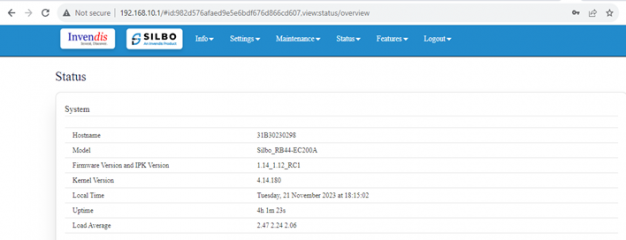
The specifications details are as follows,
| SN | Field name | Sample value | Description |
|---|---|---|---|
| 1 | Hostname | 31B30230298 | This field displays the router serial number of the device |
| 2 | Model | 31B30230298 | This field displays the model number of the device |
| 3 | Firmware Version and IPK Version | 1.14_1.12_RC1 | This field displays the firmware version and IPK version |
| 4 | Kernel Version | 4.14.180 | This field displays the kernel version of the device |
| 5 | Local Time | Tuesday, 21 November 2023 at 18:22:41 | This field displays the local time |
| 6 | Uptime | 4h 9m 19s | This field displays the uptime of the device |
| 7 | Load Average | 2.32 2.14 2.10 | This field displays the average load |
Memory
In this section it displays the memory configured specification of the device.

The specifications details are as follows.
| SN | Field name | Sample value | Description |
| 1 | Total Available | 77928 kB / 124248 kB (62%) | This field displays the total availability of memory space in the device |
| 2 | Free | 72436 kB / 124248 kB (58%) | This field displays the Free memory space in the device |
| 3 | Cached | 240 kB / 124248 kB (0%) | This field displays the Cached memory space in the device |
| 4 | Buffered | 6684 kB / 124248 kB (5%) | This field displays the Buffered memory space in the device |
Storage
In this section it displays the status of storage as root and temporary usage specification of the device.
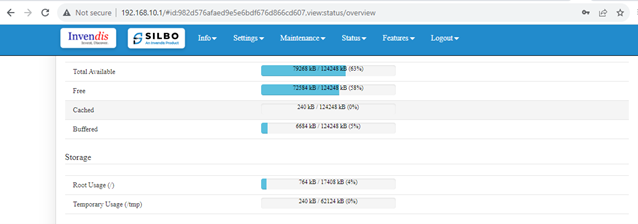
The specifications details are as follows.
| SN | Field name | Sample value | Description |
| 1 | Root Usage |
|
This field displays the total root usage of the device |
| 2 | Temporary Usage |
240 kB / 62124 kB (0%) |
This field displays the total temporary usage of the device |
Connection Tracking
In this section it displays the status of connection tracking for the device.
![]()
The specifications details are as follows.
| SN | Field name | Sample value | Description |
| 1 | Active Connection |
79 / 16384 (0%) |
This field displays the active connection of the device. |
DHCP Leases
In this section, it displays the DHCP lease of the temporary assignment of an IP address to a device on the network.
The specifications details are as follows.
| SN | Field name | Sample value | Description |
| 1 | Host Name | AnanyaA-LT | This field displays the configured Host Name/User Name for that device. |
| 2 | IPv4-Address | 192.168.10.123 | This field displays the IP address of the device. |
| 3 | MAC-Address | X:X:X:85:13:91 | This field displays the MAC-Address of the device. |
| 4 | Lease time remaining | 10h 4m 34s | This field displays the lease time remaining for the device. |
1.2 System Log
This page provides on screen System logging information.
In this page the user gets to view the system logs
1.3 Kernel Log
This page provides on-screen Kernel logging information.
In this page, the user gets to view the Kernel logs
2. Setting
In this “Setting” module the user can Configure/update all the required parameters related to Network, SIM Switch, Internet, VPN, Firewall, Loopback Rule, Remote monitoring, Tunnel as per requirement.
IT consist of 8 submodules.
- Network
- Sim Switch
- Internet
- VPN
- Firewall
- Loopback Rule
- Remote Monitoring
- Tunnel
2.1 Network
In this section the user does all the setting related configuration with reference to network like Ethernet Setting, Cellular Setting, Band lock and Operator Lock, Wi-Fi, Guest Wi-Fi, Wireless Schedule, SMS Setting, Loopback IP.
Ethernet Setting
In this page it will display all the configured port that is attached with the device.
For this device 5 ports are configured. Ethernet mode can be configured as WAN and as LAN as well. Ethernet LAN Connection settings can be configured as DHCP server or Static.
For port 5 setting
Kindly select the option LAN4 for Port 5 mode LAN/WAN. Based on the option selected the filed will also changes the user needs to configure all the required field and click on the save to save the required fields.
| SN | Field name | Sample value | Description |
| 1 | Port 5 mode LAN/WAN | LAN4 | This field displays the port mode selection |
| 2 | Port 5 ifname | eth0.5 | This field displays the ifname. |
| 3 | Port 5 Ethernet Protocol [LAN Eth0.1] | DHCP Server | This field displays the Ethernet mode selection |
| 4 | Port 5 DHCP Server IP | 192.168.10.1 | This field displays DHCP server IP configured. |
| 5 | Port 5 DHCP Netmask | 255.255.255.0 | This field displays DHCP server Netmask address configured |
| 6 | Port 5 DHCP Start Address | 100 | This field displays DHCP server start address configured |
| 7 | Port 5 DHCP Limit | 50 | This field displays DHCP server limit |
Kindly select the option EWAN2 for Port 5 mode LAN/WAN. Based on the option selected the filed will also changes the user needs to configure all the required field and click on the save to save the required fields.
| SN | Field name | Sample value | Description |
| 1 | Port 5 mode LAN/WAN | EWAN2 | This field displays the port mode selection |
| 2 | Port 5 ifname | eth0.5 | This field displays the ifname. |
| 3 | Port 5 Interface Name | EWAN2 | This field displays the Ethernet mode selection |
| 4 | Ethernet Protocol Port 5 WAN | DHCP client | This field displays the client |
| 5 | Gateway | 192.168.1.1 | This field displays gateway address configured |
Click on the save once all the configuration is done and click on the update button to update all the information.
SW_LAN settings
In this part the user can configure the setting for SW_LAN
| SN | Field name | Sample value | Description |
| 1 | SW_LAN ifname | eth0.1 | This field displays the ifname. |
| 2 | SW_LAN Interface Name | SW_LAN | This field displays the interface name. |
| 3 | SW_LAN Ethernet Protocol | DHCP Server | This field displays the Ethernet mode selection |
| 4 | SW_LAN DHCP Server IP | 192.168.10.1 | This field displays DHCP server IP configured. |
| 5 | SW_LAN DHCP Netmask | 255.255.255.0 | This field displays DHCP server Netmask address configured |
| 6 | SW_LAN DHCP Start Address | 100 | This field displays DHCP server start address configured |
| 7 | SW_LAN DHCP Limit | 50 | This field displays DHCP server limit |
| 8 | DNS Server | 1 | This filed display number of DSN server availability |
| 9 | DNS Server Address | 8.8.8.8 | This filed display the DSN server address. |
After configuring all the required information, the user should click on the save and then click on the update to update the all the required information.
Static option for SW_LAN Ethernet Protocol
Select the option of static from the drop-down menu for SW_LAN Ethernet Protocol.
| SN | Field name | Sample value | Description |
| 1 | SW_LAN ifname | eth0.1 | This field displays the ifname. |
| 2 | SW_LAN Interface Name | SW_LAN | This field displays the interface name. |
| 3 | SW_LAN Ethernet Protocol | Static | This field displays the Ethernet mode selection |
| 4 | SW_LAN static IP | 192.168.5.1 | This field displays static server IP configured. |
| 5 | SW_LAN Netmask | 255.255.255.0 | This field displays static server Netmask address configured |
| 6 | DNS Server | 1 | This filed display number of DSN server availability |
| 7 | DSN Server Address | 8.8.8.8 | This filed display the DSN server address. |
After configuring all the required information, the user should click on the save and then click on the update to update the all the required information.
Cellular Setting
In this page, the user needs to configure the various details with respect to the SIM.
select single cellular single sim where the user must configure the APN details of the sim used for the router device. The Configurations can be done based on the SIM usage, with respect to IPV4 or IPV.
| SN | Field name | Sample value | Description |
| 1 | Cellular Operation Mode | Single Cellular with Dual Sim | This field displays the cellular operation mode. |
| 2 | Cellular Modem 1 | QuectelEC200A | This field displays the modem name. |
| 3 | Network Mode | Automatic | This field displays the Network mode selection |
| 4 | SIM 1 Access Point Name | airtelgprs.com | This field displays the name of the Sim 1 access point configured. |
| 5 | SIM 1 PDP Type | IPV4 | This field displays the type of SIM 1 |
| 6 | SIM 1 Username | This field is optional, and the user can configure the name of the SIM 1 | |
| 7 | SIM 1 Password | This field is optional, and the user can configure the password for the SIM 1 | |
| 8 | SIM 1 Authentication Protocol | None | This field displays the type of protocol is being used for SIM 1 |
| 9 | SIM 2 Access Point Name | airtelgprs.com | This field displays the name of the Sim 2 access point configured. |
| 10 | SIM 2 PDP Type | IPV4 | This field displays the type of SIM 2 |
| 11 | SIM 2 Username | This field is optional, and the user can configure the name of the SIM 2 | |
| 12 | SIM 2 Password | This field is optional, and the user can configure the password for the SIM 2 | |
| 13 | SIM 2 Authentication Protocol | None | This field displays the type of protocol is being used for SIM 2 |
| 14 | Primary SIM Switchback Time (In Minutes) | 10 | This field displays the time given for sim to swich in between. |
After configuring all the required information, the user should click on the save and then click on the update to update the all the required information.
Band lock and Operator Lock
In this page, the user needs to configure the lock band and operator based on the service provider.
Bands available in the drop-down list.
2G/3G option
2G/3G: - 3G allows additional features such as mobile internet access, video calls and mobile TV. While the main function of 2G technology is the transmission of information through voice calls.
The user should select the band check box available for 2g/3g from the given list.
Bands available for selection under LTE for the bands available that zone.
Operator Selection Mode
The user needs to click on the check box of the “operator select enable” to select the operator.
Once the check box is clicked there will be a dropdown list of the operator modes from which the user needs to select the mode. The user needs to select the operator mode from the given dropdown list.
If the user selects the mode “Manual” or “Manual-Automatic” then one more text box will appear where the user must provide the operator code.
After configuring all the required information, the user should click on the save and then click on the update to update the all the required information.
Wi-Fi Setting
Wi-Fi is a family of wireless network protocols based on the IEEE 802.11 family of standards, which are commonly used for local area network of devices and internet access, allowing nearby digital devices to exchanges data by radio waves. These are the most widely used computer network, used globally in home and small office networks to link devices and to provided internet access with wireless router and wireless access point in public places. In this router has the general setting and change country code, channel, radio mode, radio passphrase as per the requirement after clicking on enable Radio button.
The user needs to select the respective radio mode based on its need. Basically, it has 3 radio mode.
Access Point mode: In Access Point mode, router connects to a wireless router through an Ethernet cable to extend the coverage of wireless signal to other network client.
Client point: In client mode, the access point connects your wired devices to a wireless network. This mode is suitable when you have a wired device with an Ethernet port and no wireless capability, for example, a smart TV, Media Player, or Game console and you want to connect it to the internet wirelessly, select the Client Mode and give the Radio SSID & client passphrase
Access point and client point: select this option for both type connection, give both SSID and passphrase.
After configuring all the required information, the user should click on the save and then click on the update to update the all the required information.
| SN | Field name | Sample value | Description |
| 1 | Radio 0 Protocol | IEEE 802.11 b/g/n | In this dropdown the user should select which protocol is being used |
| 2 | Country Code | INDIA | In this dropdown the user should select which county it belongs to . |
| 3 | Channel | Auto | In this dropdown the user should select the proper channel to be used . |
| 4 | TX Power | 100 | In this text box the user should specify the power. |
| 5 | Channel Width | 20 MHz | In this dropdown the user should select the channel width |
| 6 | Radio Mode | Access point | In this drop down the user should select the mode . |
| 7 | Radio SSID | SILBO_RB44_31B30230298 | In this text box the user should specify the SSID number |
| 8 | Radio Authentication | WPA2 Personal (PSK) | In this dropdown the user should select the type of authentication. |
| 9 | Radio Encryption | AES | In this dropdown the user should select the type of encryption required. |
| 10 | Radio Passphrase | In this text box the user should specify the password. | |
| 11 | Radio DHCP server IP | 192.168.100.1 | In this text box the user should specify the IP address of DHCP server. |
| 12 | Radio DHCP start address | 100 | In this text box the user should specify the start address of the DHCP. |
| 13 | Radio DHCP limit | 50 | In this text box the user should specify the limit for the DHCP. |
Wireless Schedule
Wi-Fi can be automatically withdrawn based on the configuration done in this section.
The user can schedule the Wi-Fi’s accessibility time during a particular period.
After configuring all the required information, the user should click on the save and then click on the update to update the all the required information.
The user can select more than one “day of the week” for scheduling the wifi working hours.
Loop back IP settings
The loopback IP address, often referred to as “localhost”. it’s used to establish network connections within the same device for testing and troubleshooting purpose.
After configuring all the required information, the user should click on the save and then click on the update to update the all the required information.
The loopback IP address, commonly represented as 127.0.0.1, is a special address used for testing network connectivity on a local machine. It allows a device to send network messages to itself without involving external networks, making it useful for troubleshooting and diagnostics.
However, this IP can be changed as per requirement and to do that, Navigating to Setting>>Network configuration>> Loopback IP settings can be changed/updated.
Above screenshot shows the configuration window from GUI/WebUI
SMS Settings
User needs to enable SMS option in SMS settings page. This option is to validate the mobile numbers using which controlling commands could be sent to the router device. 1 to 5 mobile numbers can be authenticated by choosing from “Select Valid SMS user numbers” and adding the mobile numbers below respectively. API key is the pass key used in the commands while sending SMS. Displayed in the below screen is the default API key which can be edited and changed as per choice. After addition of the mobile numbers user needs to click on save button for changes to take place.
Select valid user number max. 5 and add authorized phone number in the main menu where want to find the alert and click on SMS Response Enable, save and update button, now send SMS commands from the configured mobile number. Once the commands are received from the user phone number the board send acknowledgement as per the commands after that it will send the router’s status once it has rebooted and is operational again.
Mentioned below are a few commands which can be sent from the configured mobile number to the router device. Below two commands are One for rebooting the router device and another to get the uptime.
1) {"device":["passkey","API key"],"command":"reboot","arguments":"hardware"}
2) {"device":["passkey ","API key"],"command":"uptime"}
After configuring all the required information, the user should click on the save and then click on the update to update the all the required information.
SIM
In this page the user needs to configure the Sim for the given device.
 The user needs to select from the drop-down menu on which basis the sim needs to be switched.
The user needs to select from the drop-down menu on which basis the sim needs to be switched.
Once the user selects on “signal strength” then the parameters related to signal strength will pop up and the user needs to configure the parameters based on the requirement
Threshold RSRP
This Needs to be set appropriately. Incorrect setting may cause unnecessary SIM switching. ( In General a BAD RSRP value range is -140 to -115 and FAIR RSRP value range is -115 to -105).
Threshold SINR
This Needs to be set appropriately. Incorrect setting may cause unnecessary SIM switching. ( In General a BAD SNR value range is -20 to 0 and FAIR SNR value range is 0 to 13)
Once the user selects on “Data Limit” then the parameters related to Data Limit will pop up and the user needs to configure the parameters based on the requirement.
| SN | Field name | Sample value | Description |
| 1 | SIM Switch Based on | Data Limit | The user needs to select from the drop-down menu on what basis the sim needs to be switched. |
| 2 | SIM 1 Data Usage Limit (In MB) | 1000 | The user needs to set the limit for the data usage for SIM 1. |
| 3 | SIM 2 Data Usage Limit (In MB) | 1000 | The user needs to set the limit for the data usage for SIM 2. |
| 4 | Periodicity | Daily | The user needs to set the pattern/frequency to switch the sims. |
| 5 | Day Of Month | 16 | The user needs to set the day for switching the sim. |
After configuring all the required information, the user should click on the save.
Internet
In this page the user needs to configure the internet connection to set the priority from the various options. The user should decide what kind of connection it needs to provide to the device like LAN, WAN etc. Once the connections are configured then click on save option and then on update.
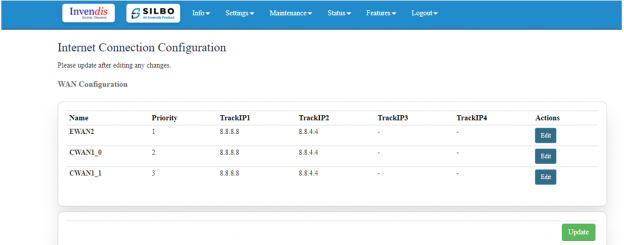 If the user needs to edit on the existing configuration, then the user should click on the “EDIT” button.
If the user needs to edit on the existing configuration, then the user should click on the “EDIT” button.
| SN | Field name | Sample value | Description |
| 1 | Name | EWAN2 | This field displays the name of the WAN connection |
| 2 | Priority | 1 | In this dropdown box the user need to select the priority. |
| 3 | Select Track IP Numbers | 2 | In this dropdown the user needs to select the track number for the Ips. |
| 4 | TrackIP1 | 8.8.8.8 | In this text field the user needs to set the IP address for the track 1 |
| 5 | TrackIP2 | 8.8.4.4 | In this text field the user needs to set the IP address for the track 1 |
| 6 | Reliability | 1 | Not sure what needs to be written |
| 7 | Count | 1 | Not sure what needs to be written |
| 8 | Up | 1 | Not sure what needs to be written |
| 9 | Down | 1 | Not sure what needs to be written |
Once the user is done with modification click on the save button to save all the changes and then click on the update button.
VPN
VPN stands for Virtual Private Network, it establishes a connection between the system and a remote server, which is owned by a VPN provider.
Creating a point-to-point tunnel that encrypts the personal data, masks the IP address, and allows to block the required website to blocks via firewalls on the internet.
There are 3 types of setting available under VPN configuration.
- General Settings
- IPSEC
- Open VPN
General Settings
In this page the user must choose which type of VPN connection is required for the device.
The user must select from IPSEC or Open VPN based on its requirement. If required, the user can select for both the options.
The user needs to click on the save after selecting the option based on its requirement.
IPSEC
IPSEC VPN is used to create a VPN connection between local and remote networks. To use IPSEC VPN, the user should check that both local and remote routers support IPSEC VPN feature.
In this page the user can add/edit/delete the IPSEC VPN connection for the device.
The user needs to click on the update button once the required configuration is completed.
In IPSEC the user needs to click on edit button to edit the configuration of an existing VPN connection.
Click on the save button after the required configuration.
| SN | Field name | Sample value | Description |
| 1 | IPSEC | Site to Site VPN | In this dropdown the user should select the IPSEC connection type. |
| 2 | IPSEC Role | Client/Server | In this dropdown box the user needs to select the IPSEC role. |
| 3 | Connection Type | Tunnel | In this dropdown the user needs to select the connection type. The user should select on the connection enable check box. |
| 4 | Connection mode | start | In this drop down list the user should select the mode for the connection. it will have route/add/start/trap mode |
| 5 | Remote Server IP | 1.1.1.1 | In this text field the user needs to set the IP address for the remote server. |
| 6 | Local ID | g300 | The user needs to needs to set the local id . |
| 7 | No. of local subnets | 1 | In this dropdown the user needs to select how many subnet it will be connected. |
| 8 | Local Subnet 1 | 192.168.11.1/24 | In this text box the user needs to put the address of the local subnet. |
| 9 | Remote id | sophos | In this text box the user needs to put the id of the remote connection. |
| 10 | No of remote subnet | 1 | In this dropdown the user needs to select how many subnet it will be connected remotely. |
| 11 | Remote subnet | 192.168.10.0/24 | In this text box the user needs to put the address of the remote subnet. |
| 12 | Keyexchange | Ikev1 | Not sure what needs to be written. |
| 13 | Aggressive | Yes/No | Not sure what needs to be written. |
| 14 | IKE life time | 8 | Not sure what needs to be written |
| 15 | Lifetime in seconds | 1 | Not sure what needs to be written |
Open VPN
In the OpenVPN connection, the home network can act as a server, and the remote device can access the server through the router which acts as an OpenVPN Server gateway. To use the VPN feature, the user should enable OpenVPN Server on the router, and install and run VPN client software on the remote device.
The user needs to upload the respective certificate from a valid path and then click on the “Start”.
Once the openvpn connection starts the user will get an option to stop the VPN connection as and when required. By clicking on the Stop button, the user can stop the VPN connection.

